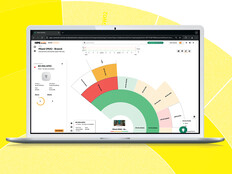Go with the Flow
Amount due: $157,688.49. This was just one of thousands of water bills that went uncollected by the New York City Department of Environmental Protection (DEP).
The problem was that the DEP couldn't stand behind its bills. It paid the city's energy supplier, Con Edison, $3.6 million per year to read water meters each quarter, but Con Ed couldn't access 15 percent of the meters. That meant DEP had to estimate those water bills, and customers often refused to pay.
DEP had spent years investigating ways to improve its read rate, increase bill collection and cut contractor costs with an automated meter reading (AMR) system. But building a wireless network to transmit the data would have been a massive undertaking, says Cecil ÂMcMaster, assistant commissioner and CIO. "I'm not sure the cost-benefit analysis would have made sense," he says. "It probably wouldn't have happened."
Instead, DEP overlaid a data collection network for advanced metering infrastructure (AMI) on top of the wireless network the New York City Department of ÂInformation Technology and Telecommunications was deploying citywide.
"It was one of those serendipitous moments," says Steven Harte, DoITT's associate commissioner for wireless technologies. "The two projects meshed and were on the same timeline."
DEP is well into its $252 million AMR/AMI project, and it's already seen vast improvements in read rates and customer service. The 500,000 meters that had been installed by October have experienced read rates of greater than 98 percent. With the new system, meter reads are transmitted to DEP at least four times a day instead of four times a year. The fees paid to Con Ed are gone, and an ever-growing number of customers can go online to see how much water they're using in real time.
"There's a lot of risk with a big project like this, especially in a city like New York," says McMaster. "But it's going excellently. The feedback we're getting from the constituents is very positive."
California and Texas lead the nation in smart-meter programs, but the New York City DEP is the largest water agency to move in this direction. As it heads into its final year of the project, on budget and ahead of schedule, it's giving utilities around the world ideas on how to shave costs, increase revenues and improve customer service.
That's just the start, says Gregg Edeson, a management team member at PA Consulting Group. The real value comes when customers get accurate, real-time information about their water use. When they see how much it costs to water the flower garden after work or spend an extra five minutes in the shower, they'll be motivated to change their behavior.
"It's Metering 2.0," says Edeson. "It's the next step. This is not going away."
Charting a New Course
Warren C. Liebold is nuts. At least, that's what one of his former colleagues said of him as he relentlessly pushed for an AMR system at DEP.
As the agency's director of metering/conservation, Liebold wrote the original feasibility paper for AMR back in 2003, and he's been on hand for various pilots involving everything from a landline phone–based system to one in which trucks would drive up and down streets wirelessly collecting data from meters.
But there were two key factors that turned his vision for AMR into reality. The first was DoITT's wireless network, NYCWiN. And the second was Cecil McMaster.
"If a water utility doesn't have a strong IT shop, it's not going to be able to do this well," says Liebold. "Cecil is very good at sizing up what needs to be done from his end and having a team around him who can do that in a detailed way and very quickly."
It took a while to build that team, admits McMaster. He worked at DEP for eight years, left to work at Prudential Security for four, then returned in 2004 to head up the agency's 170-person IT shop. His background with DEP coupled with the insight he gained on Wall Street gave him clarity: The agency had sophisticated technology at its disposal, but much of it went unused because it wasn't driven by business needs.
"If you have a fancy tool but nobody's using it, is it really innovative?" poses McMaster.
835,000
Number of meter transmitter units slated for rollout by late 2011 or early 2012
Source: NYC DEP
He pushed his team to stop focusing on their projects and begin thinking about the agency's critical services. "We started to do things that really impacted the business," he says.
That's when the AMR/AMI project was building steam. "Cecil had immediate enthusiasm and support for the project," says Liebold. "He realizes that what his team is doing contributes to the larger goals that the agency has."
A Perfect Partnership
As DEP searched for the right solution, DoITT was beginning to roll out NYCWiN.
The idea for a citywide wireless network took form after the Sept. 11 terrorist attacks.
Its primary purpose is to support public safety workers, but a host of other agencies benefit from the network. DoITT can prioritize the data on the network, so NYCWiN could be used for everything from deploying counter-terrorism initiatives to conducting day-to-day inspections, says Harte.
"The DEP project is a clear example of how leveraging an asset the city had deployed could not only save money but better serve the citizens of New York," Harte adds. It let NYCWiN deliver value out of the gate.
DEP's takeaway from the partnership is clear: It got a fixed wireless network without having to build one on its own. With the wireless network in place, DEP piloted its system in summer 2007. It tested it with two vendors in Lower Manhattan and Northeast Brooklyn and chose Aclara's STAR Network AMI system in 2008.
DoITT and DEP had Northrop Grumman, Aclara and four other vendors install the advanced metering infrastructure, and DEP purchased Cisco routers and switches from CDW·G to support the project. McMaster's team built applications to move the data from the AMR system into the agency's legacy billing system, and it created another application to manage the massive undertaking of installing hundreds of thousands of new meters and meter transmitter units. MTUs are wired to meters and transmit their data wirelessly to data collection units. The DCU receivers then pass along those readings to the DEP's AMR/AMI servers.
"We did everything electronically," says McMaster. Contractors use handheld devices to collect addresses, equipment serial numbers and details on the installations, then they upload that information at the end of each day to the web-based application that DEP built.
"We reduced our errors probably a thousand percent just by automating and putting handhelds in the field," says McMaster.
Another reason the project has been so smooth is because DEP used multiple vendors to install the MTUs and meters. "So when one was dropping off in performance, we could ask other vendors to pick up the slack," McMaster explains. "I thought it was going to be problematic, but it served us tremendously."
If the IT team hadn't been so competent, DEP would have had to outsource the data management to an AMR vendor, says Liebold. "AMR can rise and fall based on how you handle it from an IT perspective, and we've got a very good IT shop."

Cecil McMaster concedes the NYC automated meter reading project was risky, but fortunately has gone great.
Photo: John Emerson
A Clear Choice
A September Daily News story slammed Mayor Michael Bloomberg for pushing ahead with the AMI project despite the city's fiscal crunch. But, counters Liebold, if the headlines aren't about the AMI project, they're about the poor old lady who gets an outrageous water bill during tough economic times.
"Providing good customer service has a value that needs to be recognized," he says, "because when we're providing bad customer service, people certainly notice."
So the question wasn't whether to undertake an AMR initiative; it was what type of initiative made the most sense. With a drive-by system, DEP would need to maintain a fleet of trucks and hire drivers. "It becomes a lot to manage," McMaster says. Plus, the cost of a drive-by system is very close to that of a fixed-network system.
400,000
Number of outdated meters the NYC DEP is replacing
With a fixed network, the entire $3.6 million Con Ed cost -- an expense that would likely have grown significantly -- goes away, says Liebold. Because Con Ed has to read the electric meters, it charges DEP only a minimal fee. But Con Ed itself has been looking into AMI, so if it stops reading its own meters, DEP would have needed to pay a new contractor to establish a meter-reading operation in the city.
Cost reduction was reason enough to undertake the project. But, says McMaster, "If you look long term, as people become savvy about using water, we may not need to build out the water infrastructure as fast as we are because we would need less water. You're talking about saving billions of dollars down the road, where we don't need new reservoirs. The potential is there for this to be huge."
Cutting Consumption
Municipalities are using smart meters to encourage conservation, with programs such as:
- E-mail, text and voicemail alerts notifying customers of sharp changes in usage that could be caused by leaks
- Demand response, in which customers give permission for utilities to cut off their appliances in exchange for discounts
- Tiered rate structures, which charge more to high-use customers
- Dynamic pricing, which charges higher rates during peak times







